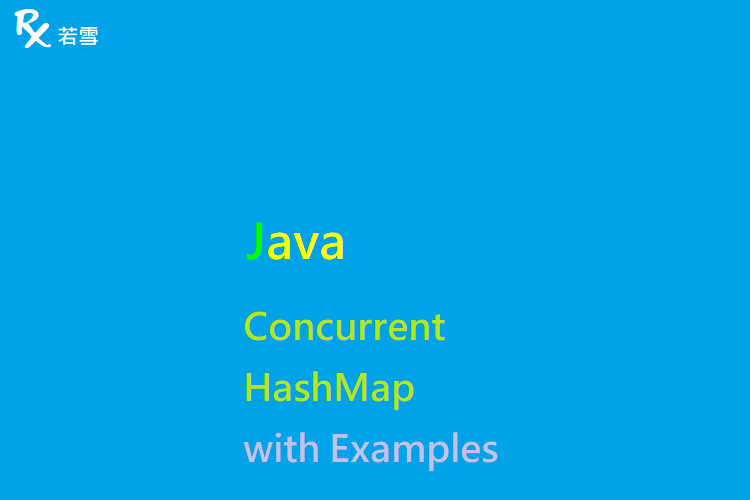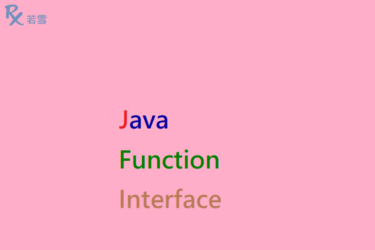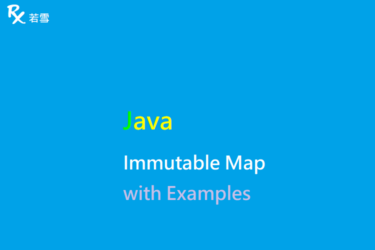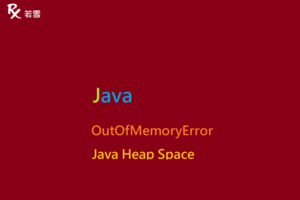Table of Contents
ToggleConcurrentHashMap in Java with Examples
是執行緒安全的,即多個執行緒可以對單一物件進行操作,而不會出現任何複雜情況,任意數量的執行緒都可以執行檢索操作,但是要更新對象,必須鎖定該執行緒想要操作的特定區段,預設並發等級是 16 ,執行緒一次可以執行 16 個更新操作, ConcurrentHashMap in Java 介紹常見的 entrySet 、 forEach 、 toArray 等方法,本篇增加了範例,並透過單元測試來驗證產出結果。
檔案目錄
./
+- src
+- test
| +- org
| +- ruoxue
| +- java_147
| +- map
| +- concurrenthashmap
| +- ConcurrentHashMapWithExamplesTest.java 單元測試
ConcurrentHashMap Java 提供循環訪問、轉成陣列等操作 Map 中的元素。
Fruit
建立 Fruit 物件,覆寫 equals 、 hashCode ,定義屬性和方法,用來建立一個物件。
@NoArgsConstructor
@Getter
@Setter
@Builder
public static class Fruit {
private String name;
private double quantity;
private int type;
public Fruit(String name, double quantity, int type) {
this.name = name;
this.quantity = quantity;
this.type = type;
}
public String toString() {
ToStringBuilder builder = new ToStringBuilder(this, ToStringStyle.JSON_STYLE);
builder.appendSuper(super.toString());
builder.append("name", name);
builder.append("quantity", quantity);
builder.append("type", type);
return builder.toString();
}
public boolean equals(Object object) {
if (!(object instanceof Fruit)) {
return false;
}
if (this == object) {
return true;
}
Fruit other = (Fruit) object;
return new EqualsBuilder().append(getName(), other.getName()).isEquals();
}
public int hashCode() {
return new HashCodeBuilder().append(getName()).toHashCode();
}
}iteratorThrowException
ConcurrentHashMap Java 建立一個 HashMap ,增加三個元素,多執行緒進行讀取元素時,同時寫入元素,會拋出例外。
@Test
public void iteratorThrowException() {
try {
int poolSize = 5;
ExecutorService executorService = Executors.newFixedThreadPool(poolSize);
Map<String, Fruit> map = new HashMap<>();
map.put("Grape", new Fruit("Grape", -1, 1));
map.put("Kiwifruit", new Fruit("Kiwifruit", Double.MAX_VALUE, 2));
map.put("Lemon", new Fruit("Lemon", 1, 3));
IntStream.range(0, poolSize).forEach(e -> {
executorService.execute(() -> {
Iterator<String> it = map.keySet().iterator();
while (it.hasNext()) {
System.out.println(String.format("[%d] %s", Thread.currentThread().getId(), it.next()));
}
});
});
IntStream.range(0, poolSize).forEach(e -> {
executorService.execute(() -> {
map.put("Papaya", new Fruit("Papaya", 1, 1));
});
});
Thread.sleep(2_000L);
} catch (Exception ex) {
ex.printStackTrace();
}
}[11] Grape
[13] Grape
[11] Kiwifruit
[12] Grape
[15] Grape
[14] Grape
[12] Kiwifruit
[15] Kiwifruit
[14] Kiwifruit
[15] Lemon
[11] Lemon
[13] Kiwifruit
[14] Lemon
[12] Lemon
Exception in thread "pool-1-thread-3" java.util.ConcurrentModificationException
at java.util.HashMap$HashIterator.nextNode(HashMap.java:1445)
at java.util.HashMap$KeyIterator.next(HashMap.java:1469)
at org.ruoxue.java_147.map.concurrenthashmap.ConcurrentHashMapWithExamplesTest.lambda$1(ConcurrentHashMapWithExamplesTest.java:81)iterator
ConcurrentHashMap Java 建立一個 ConcurrentHashMap ,增加三個元素,多執行緒進行讀寫元素時,能夠安全地遍歷集合。
@Test
public void iterator() {
try {
int poolSize = 5;
ExecutorService executorService = Executors.newFixedThreadPool(poolSize);
Map<String, Fruit> map = new ConcurrentHashMap<>();
map.put("Grape", new Fruit("Grape", -1, 1));
map.put("Kiwifruit", new Fruit("Kiwifruit", Double.MAX_VALUE, 2));
map.put("Lemon", new Fruit("Lemon", 1, 3));
IntStream.range(0, poolSize).forEach(e -> {
executorService.execute(() -> {
Iterator<String> it = map.keySet().iterator();
while (it.hasNext()) {
System.out.println(String.format("[%d] %s", Thread.currentThread().getId(), it.next()));
}
});
});
IntStream.range(0, poolSize).forEach(e -> {
executorService.execute(() -> {
map.put("Papaya", new Fruit("Papaya", 1, 1));
});
});
Thread.sleep(2_000L);
} catch (Exception ex) {
ex.printStackTrace();
}
}[14] Grape
[15] Grape
[11] Grape
[12] Grape
[11] Kiwifruit
[13] Grape
[12] Kiwifruit
[11] Lemon
[12] Lemon
[15] Kiwifruit
[14] Kiwifruit
[13] Kiwifruit
[14] Lemon
[13] Lemon
[15] Lemon
entrySet
ConcurrentHashMap Java 建立一個 ConcurrentHashMap ,內有三個元素,迴圈取得元素。
@Test
public void entrySet() {
Map<String, Fruit> map = new ConcurrentHashMap<>();
map.put("Grape", new Fruit("Grape", -1, 1));
map.put("Kiwifruit", new Fruit("Kiwifruit", Double.MAX_VALUE, 2));
map.put("Lemon", new Fruit("Lemon", 1, 3));
for (Map.Entry<String, Fruit> e : map.entrySet()) {
System.out.println(e.getKey() + ", " + e.getValue());
}
}Grape, {"name":"Grape","quantity":-1.0,"type":1}
Kiwifruit, {"name":"Kiwifruit","quantity":1.7976931348623157E308,"type":2}
Lemon, {"name":"Lemon","quantity":1.0,"type":3}
forEach
ConcurrentHashMap Java 建立一個 ConcurrentHashMap ,內有三個元素,迴圈取得元素。
@Test
public void forEach() {
Map<String, Fruit> map = new ConcurrentHashMap<>();
map.put("Grape", new Fruit("Grape", -1, 1));
map.put("Kiwifruit", new Fruit("Kiwifruit", Double.MAX_VALUE, 2));
map.put("Lemon", new Fruit("Lemon", 1, 3));
map.forEach((k, v) -> System.out.println(k + ", " + v));
}Grape, {"name":"Grape","quantity":-1.0,"type":1}
Kiwifruit, {"name":"Kiwifruit","quantity":1.7976931348623157E308,"type":2}
Lemon, {"name":"Lemon","quantity":1.0,"type":3}
keyForEach
ConcurrentHashMap Java 建立一個 ConcurrentHashMap ,內有三個元素,迴圈取得 key 元素。
@Test
public void keyForEach() {
Map<String, Fruit> map = new ConcurrentHashMap<>();
map.put("Grape", new Fruit("Grape", -1, 1));
map.put("Kiwifruit", new Fruit("Kiwifruit", Double.MAX_VALUE, 2));
map.put("Lemon", new Fruit("Lemon", 1, 3));
map.keySet().forEach(e -> System.out.println(e));
}Grape
Kiwifruit
Lemon
keyForEachRemaining
ConcurrentHashMap Java 建立一個 ConcurrentHashMap ,內有三個元素,迴圈取得 key 剩餘元素。
@Test
public void keyForEachRemaining() {
Map<String, Fruit> map = new ConcurrentHashMap<>();
map.put("Grape", new Fruit("Grape", -1, 1));
map.put("Kiwifruit", new Fruit("Kiwifruit", Double.MAX_VALUE, 2));
map.put("Lemon", new Fruit("Lemon", 1, 3));
Set<String> set = map.keySet();
Iterator<String> it = set.iterator();
int i = 0;
while (it.hasNext()) {
System.out.println(it.next());
if (i == 1) {
break;
}
i++;
}
System.out.println("----------");
it.forEachRemaining(e -> {
System.out.println(e);
});
}
Grape
Kiwifruit
----------
LemonkeyIterator
Java ConcurrentHashMap 建立一個 ConcurrentHashMap ,內有三個元素,迴圈取得 key 元素。
@Test
public void keyIterator() {
Map<String, Fruit> map = new ConcurrentHashMap<>();
map.put("Grape", new Fruit("Grape", -1, 1));
map.put("Kiwifruit", new Fruit("Kiwifruit", Double.MAX_VALUE, 2));
map.put("Lemon", new Fruit("Lemon", 1, 3));
Iterator<String> it = map.keySet().iterator();
while (it.hasNext()) {
System.out.println(it.next());
}
}Grape
Kiwifruit
LemonvalueForEach
Java ConcurrentHashMap 建立一個 ConcurrentHashMap ,內有三個元素,迴圈取得 value 元素。
@Test
public void valueForEach() {
Map<String, Fruit> map = new ConcurrentHashMap<>();
map.put("Grape", new Fruit("Grape", -1, 1));
map.put("Kiwifruit", new Fruit("Kiwifruit", Double.MAX_VALUE, 2));
map.put("Lemon", new Fruit("Lemon", 1, 3));
map.values().forEach(System.out::println);
}{"name":"Grape","quantity":-1.0,"type":1}
{"name":"Kiwifruit","quantity":1.7976931348623157E308,"type":2}
{"name":"Lemon","quantity":1.0,"type":3}
valueForEachRemaining
Java ConcurrentHashMap 建立一個 ConcurrentHashMap ,內有三個元素,迴圈取得 value 剩餘元素。
@Test
public void valueForEachRemaining() {
Map<String, Fruit> map = new ConcurrentHashMap<>();
map.put("Grape", new Fruit("Grape", -1, 1));
map.put("Kiwifruit", new Fruit("Kiwifruit", Double.MAX_VALUE, 2));
map.put("Lemon", new Fruit("Lemon", 1, 3));
Collection<Fruit> collection = map.values();
Iterator<Fruit> it = collection.iterator();
int i = 0;
while (it.hasNext()) {
System.out.println(it.next());
if (i == 1) {
break;
}
i++;
}
System.out.println("----------");
it.forEachRemaining(e -> {
System.out.println(e);
});
}{"name":"Grape","quantity":-1.0,"type":1}
{"name":"Kiwifruit","quantity":1.7976931348623157E308,"type":2}
----------
{"name":"Lemon","quantity":1.0,"type":3}valueIterator
Java ConcurrentHashMap 建立一個 ConcurrentHashMap ,內有三個元素,迴圈取得 value 元素。
@Test
public void valueIterator() {
Map<String, Fruit> map = new ConcurrentHashMap<>();
map.put("Grape", new Fruit("Grape", -1, 1));
map.put("Kiwifruit", new Fruit("Kiwifruit", Double.MAX_VALUE, 2));
map.put("Lemon", new Fruit("Lemon", 1, 3));
Iterator<Fruit> it = map.values().iterator();
while (it.hasNext()) {
System.out.println(it.next());
}
}{"name":"Grape","quantity":-1.0,"type":1}
{"name":"Kiwifruit","quantity":1.7976931348623157E308,"type":2}
{"name":"Lemon","quantity":1.0,"type":3}
keyToArray
Java ConcurrentHashMap 建立一個 ConcurrentHashMap ,內有三個元素, key 轉換成 String 陣列, Java ConcurrentHashMap Example 提供範例參考。
@Test
public void keyToArray() {
int expectedSize = 3;
Map<String, Fruit> map = new ConcurrentHashMap<>();
map.put("Grape", new Fruit("Grape", -1, 1));
map.put("Kiwifruit", new Fruit("Kiwifruit", Double.MAX_VALUE, 2));
map.put("Lemon", new Fruit("Lemon", 1, 3));
String[] array = new String[map.size()];
map.keySet().toArray(array);
for (String e : array) {
System.out.println(e);
}
assertEquals(expectedSize, array.length);
}Grape
Kiwifruit
LemonkeyStreamToArray
Java ConcurrentHashMap 建立一個 ConcurrentHashMap ,內有三個元素,使用 stream , key 轉換成 String 陣列, Java ConcurrentHashMap Example 提供範例參考。
@Test
public void keyStreamToArray() {
int expectedSize = 3;
Map<String, Fruit> map = new ConcurrentHashMap<>();
map.put("Grape", new Fruit("Grape", -1, 1));
map.put("Kiwifruit", new Fruit("Kiwifruit", Double.MAX_VALUE, 2));
map.put("Lemon", new Fruit("Lemon", 1, 3));
String[] array = map.keySet().stream().toArray(String[]::new);
for (String e : array) {
System.out.println(e);
}
assertEquals(expectedSize, array.length);
}Grape
Kiwifruit
LemonConcurrentHashMapWithExamplesTest.java
ConcurrentHashMap in Java 新增單元測試,驗證 Java ConcurrentHashMap Example 是否符合預期。
package org.ruoxue.java_147.map.concurrenthashmap;
import static org.junit.Assert.*;
import java.util.Collection;
import java.util.HashMap;
import java.util.Iterator;
import java.util.Map;
import java.util.Set;
import java.util.concurrent.ConcurrentHashMap;
import java.util.concurrent.ExecutorService;
import java.util.concurrent.Executors;
import java.util.stream.IntStream;
import org.apache.commons.lang3.builder.EqualsBuilder;
import org.apache.commons.lang3.builder.HashCodeBuilder;
import org.apache.commons.lang3.builder.ToStringBuilder;
import org.apache.commons.lang3.builder.ToStringStyle;
import org.junit.Test;
import lombok.Builder;
import lombok.Getter;
import lombok.NoArgsConstructor;
import lombok.Setter;
public class ConcurrentHashMapWithExamplesTest {
@NoArgsConstructor
@Getter
@Setter
@Builder
public static class Fruit {
private String name;
private double quantity;
private int type;
public Fruit(String name, double quantity, int type) {
this.name = name;
this.quantity = quantity;
this.type = type;
}
public String toString() {
ToStringBuilder builder = new ToStringBuilder(this, ToStringStyle.JSON_STYLE);
builder.appendSuper(super.toString());
builder.append("name", name);
builder.append("quantity", quantity);
builder.append("type", type);
return builder.toString();
}
public boolean equals(Object object) {
if (!(object instanceof Fruit)) {
return false;
}
if (this == object) {
return true;
}
Fruit other = (Fruit) object;
return new EqualsBuilder().append(getName(), other.getName()).isEquals();
}
public int hashCode() {
return new HashCodeBuilder().append(getName()).toHashCode();
}
}
@Test
public void iteratorThrowException() {
try {
int poolSize = 5;
ExecutorService executorService = Executors.newFixedThreadPool(poolSize);
Map<String, Fruit> map = new HashMap<>();
map.put("Grape", new Fruit("Grape", -1, 1));
map.put("Kiwifruit", new Fruit("Kiwifruit", Double.MAX_VALUE, 2));
map.put("Lemon", new Fruit("Lemon", 1, 3));
IntStream.range(0, poolSize).forEach(e -> {
executorService.execute(() -> {
Iterator<String> it = map.keySet().iterator();
while (it.hasNext()) {
System.out.println(String.format("[%d] %s", Thread.currentThread().getId(), it.next()));
}
});
});
IntStream.range(0, poolSize).forEach(e -> {
executorService.execute(() -> {
map.put("Papaya", new Fruit("Papaya", 1, 1));
});
});
Thread.sleep(2_000L);
} catch (Exception ex) {
ex.printStackTrace();
}
}
@Test
public void iterator() {
try {
int poolSize = 5;
ExecutorService executorService = Executors.newFixedThreadPool(poolSize);
Map<String, Fruit> map = new ConcurrentHashMap<>();
map.put("Grape", new Fruit("Grape", -1, 1));
map.put("Kiwifruit", new Fruit("Kiwifruit", Double.MAX_VALUE, 2));
map.put("Lemon", new Fruit("Lemon", 1, 3));
IntStream.range(0, poolSize).forEach(e -> {
executorService.execute(() -> {
Iterator<String> it = map.keySet().iterator();
while (it.hasNext()) {
System.out.println(String.format("[%d] %s", Thread.currentThread().getId(), it.next()));
}
});
});
IntStream.range(0, poolSize).forEach(e -> {
executorService.execute(() -> {
map.put("Papaya", new Fruit("Papaya", 1, 1));
});
});
Thread.sleep(2_000L);
} catch (Exception ex) {
ex.printStackTrace();
}
}
@Test
public void entrySet() {
Map<String, Fruit> map = new ConcurrentHashMap<>();
map.put("Grape", new Fruit("Grape", -1, 1));
map.put("Kiwifruit", new Fruit("Kiwifruit", Double.MAX_VALUE, 2));
map.put("Lemon", new Fruit("Lemon", 1, 3));
for (Map.Entry<String, Fruit> e : map.entrySet()) {
System.out.println(e.getKey() + ", " + e.getValue());
}
}
@Test
public void forEach() {
Map<String, Fruit> map = new ConcurrentHashMap<>();
map.put("Grape", new Fruit("Grape", -1, 1));
map.put("Kiwifruit", new Fruit("Kiwifruit", Double.MAX_VALUE, 2));
map.put("Lemon", new Fruit("Lemon", 1, 3));
map.forEach((k, v) -> System.out.println(k + ", " + v));
}
@Test
public void keyForEach() {
Map<String, Fruit> map = new ConcurrentHashMap<>();
map.put("Grape", new Fruit("Grape", -1, 1));
map.put("Kiwifruit", new Fruit("Kiwifruit", Double.MAX_VALUE, 2));
map.put("Lemon", new Fruit("Lemon", 1, 3));
map.keySet().forEach(e -> System.out.println(e));
}
@Test
public void keyForEachRemaining() {
Map<String, Fruit> map = new ConcurrentHashMap<>();
map.put("Grape", new Fruit("Grape", -1, 1));
map.put("Kiwifruit", new Fruit("Kiwifruit", Double.MAX_VALUE, 2));
map.put("Lemon", new Fruit("Lemon", 1, 3));
Set<String> set = map.keySet();
Iterator<String> it = set.iterator();
int i = 0;
while (it.hasNext()) {
System.out.println(it.next());
if (i == 1) {
break;
}
i++;
}
System.out.println("----------");
it.forEachRemaining(e -> {
System.out.println(e);
});
}
@Test
public void keyIterator() {
Map<String, Fruit> map = new ConcurrentHashMap<>();
map.put("Grape", new Fruit("Grape", -1, 1));
map.put("Kiwifruit", new Fruit("Kiwifruit", Double.MAX_VALUE, 2));
map.put("Lemon", new Fruit("Lemon", 1, 3));
Iterator<String> it = map.keySet().iterator();
while (it.hasNext()) {
System.out.println(it.next());
}
}
@Test
public void valueForEach() {
Map<String, Fruit> map = new ConcurrentHashMap<>();
map.put("Grape", new Fruit("Grape", -1, 1));
map.put("Kiwifruit", new Fruit("Kiwifruit", Double.MAX_VALUE, 2));
map.put("Lemon", new Fruit("Lemon", 1, 3));
map.values().forEach(System.out::println);
}
@Test
public void valueForEachRemaining() {
Map<String, Fruit> map = new ConcurrentHashMap<>();
map.put("Grape", new Fruit("Grape", -1, 1));
map.put("Kiwifruit", new Fruit("Kiwifruit", Double.MAX_VALUE, 2));
map.put("Lemon", new Fruit("Lemon", 1, 3));
Collection<Fruit> collection = map.values();
Iterator<Fruit> it = collection.iterator();
int i = 0;
while (it.hasNext()) {
System.out.println(it.next());
if (i == 1) {
break;
}
i++;
}
System.out.println("----------");
it.forEachRemaining(e -> {
System.out.println(e);
});
}
@Test
public void valueIterator() {
Map<String, Fruit> map = new ConcurrentHashMap<>();
map.put("Grape", new Fruit("Grape", -1, 1));
map.put("Kiwifruit", new Fruit("Kiwifruit", Double.MAX_VALUE, 2));
map.put("Lemon", new Fruit("Lemon", 1, 3));
Iterator<Fruit> it = map.values().iterator();
while (it.hasNext()) {
System.out.println(it.next());
}
}
@Test
public void keyToArray() {
int expectedSize = 3;
Map<String, Fruit> map = new ConcurrentHashMap<>();
map.put("Grape", new Fruit("Grape", -1, 1));
map.put("Kiwifruit", new Fruit("Kiwifruit", Double.MAX_VALUE, 2));
map.put("Lemon", new Fruit("Lemon", 1, 3));
String[] array = new String[map.size()];
map.keySet().toArray(array);
for (String e : array) {
System.out.println(e);
}
assertEquals(expectedSize, array.length);
}
@Test
public void keyStreamToArray() {
int expectedSize = 3;
Map<String, Fruit> map = new ConcurrentHashMap<>();
map.put("Grape", new Fruit("Grape", -1, 1));
map.put("Kiwifruit", new Fruit("Kiwifruit", Double.MAX_VALUE, 2));
map.put("Lemon", new Fruit("Lemon", 1, 3));
String[] array = map.keySet().stream().toArray(String[]::new);
for (String e : array) {
System.out.println(e);
}
assertEquals(expectedSize, array.length);
}
}心得分享
Java ConcurrentHashMap Example 可供多個線程同時使用,使其成為需要處理並發存取資料的理想選擇,與鎖定整個資料結構的其他同步機制不同,使用細粒度鎖定僅鎖定集合中被修改的部分,即使在大並發存取下也能夠實現高效能,提供了幾種 ConcurrentHashMap 常見方法的操作範例,在應用上相當廣泛,熟悉 Java ConcurrentHashMap 這些方法的操作,像是: entrySet 、 forEach 、 toArray 等方法。




